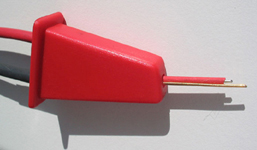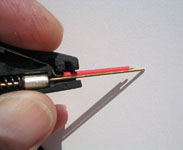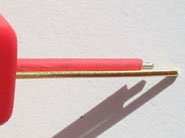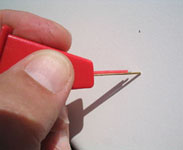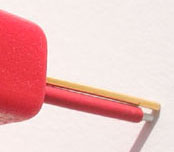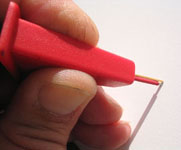Parrot Push KELVIN Probe
PARROT INVENT – SOMETHING WAS MISSING BEFORE ®
Kelvin Test Probes have to provide 4 contacts at the same time. There are 2 probes and 2 contacts to be made for each test probe.
The Parrot Push KELVIN Probe ( PPKP ) has 2 needles connected to the 2 leads.
One needle F (red insulation) is fixed to the body of the PPKP probe.
The other needle M (gold plated) is mobile, ressed by a metal spring outside the body. The tip of the mobile needle M is emerging out the body and further the fix needle F.
By pressing the PPKP to the measuring surface or device the M needle is pressed inside the PPKP body until the F needle makes the contact to the measured surface or device.
It is recommended to connect the moving needles M (gold plated) cable to the Current plug of the 4 points measuring instrument bridges, LCR meters, Ohmmeter.
At the same time the Fix needle F (red insulation) cable is recommended to be connected to the Voltage ( Sense ) plug of the 4 points measuring instrument.
Parrot Push Kelvin Test Leads, based on the Parrot™ Push Patent Pending Invention provides HQ, accurate, reliable contacts.
The Parrot PPKP Test Probes are the best solution for bridges, LCR meters, Ohmmeter.
Parrot Kelvin Test Probes provide reliable, accurate, hands-free connection in narrow spaces, due to the small metal size of the tips of Parrot Clips. Alligator clips need large space to make connections. One hook clip, two hooks clip provides poor quality connections.
PPKP test leads are very valuable for low resistance, and precise measurements.The measuring error due to the PPKP is as less than 0,5 moms.Short-circuits on circuit boards are easy to be detected.
Evaluate the Parrot™ Clip Models in order to find the best model for your application.
Visit the ParrotTM Clips Models page for more details about tip sizes, body design and electrical parameters.
Parrot Push Kelvin probes offer:
a) Commodity to handle
b) Reliable, low resistance, direct point, hands-on measurements. The metal tip is directly soldered to the lead so the contact resistance is less than 5 mohm.

